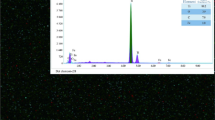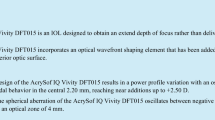Abstract
In this study, the clamping stress and force involved in the centering of optical glass lens were evaluated and quantified. On the basis of the key design parameters of the examined clamps, the finite element method was applied to predict clamping stress under various parameter combinations. Support vector regression, Gaussian process regression, and adaptive neuro fuzzy inference system algorithm of surrogate models were established using the results obtained through finite element simulation. These surrogate models, which can predict clamping stress on the basis of key parameters, can reduce the time required to perform finite element analysis while providing references for optimizing clamp configuration.















Similar content being viewed by others
Data availability
Not applicable.
Code availability
Not applicable.
References
Latyev SM, Rumyantsev DM, Kuritsyn PA (2013) Design and process methods of centering lens systems. J Opt Technol 80(3):197–200
Beier M, Gebhardt A, Eberhardt R, Tünnermann A (2012) Lens centering of aspheres for high-quality optics. THOSS Media & DE GRUYTER, Adv Opt Technol 1(6):441–446
Liu CW, Shiu SC, Yu KH (2022) Analysis of the optical quartz lens centering process based on acoustic emission signal processing and the support vector machine. Int J Adv Manuf Technol
Dengkui F, Wenfeng D, Qing M, Jiuhua X (2017) Simulation research on the grinding forces and stresses distribution in single-grain surface grinding of Ti-6Al-4V alloy when considering the actual cutting-depth variation. Int J Adv Manuf Technol 91:9–12
Javed MF, Ramli NH, Kashif-ur-Rehman S, Khan NB (2017) Finite element analysis on the structural behaviour of square CFST beams, IOP Conference Series Materials Science and Engineering 210(1):012018, 5–6 April 2017. University of Malaya, Kuala Lumpur, Malaysia
Ma Q, Lin Z, Yu Z (2009) Prediction of deformation behavior and microstructure evolution in heavy forging by FEM. Int J Adv Manuf Technol 40:253–260
Tuominen V (2011) Virtual clamping in automotive production line measurement. Expert Syst Appl 38:15065–15074
Olshevskiy A, Yang HI, Kim CW (2011) Finite element simulation of inelastic contact for arbitrarily shaped rough bodies. ARCHIVE Proc Inst Mech Eng Part C J Mechanical Eng Sci 1989–1996 (vols 203–210) 226(3):595–606
Liu Z, Kang R, Liu H, Dong Z, Bao Y, Gao S, Zhu X (2020) FEM-based optimization approach to machining strategy for thin-walled parts made of hard and brittle materials. Int J Adv Manuf Technol 110:1399–1413
Lee KS, Lin JC (2006) Design of the runner and gating system parameters for a multi-cavity injection mould using FEM and neural network. Int J Adv Manuf Technol 27:1089–1096
Ryser M, Neuhauser FM, Hein C, Hora P, Bambach M (2021) Surrogate model–based inverse parameter estimation in deep drawing using automatic knowledge acquisition. Int J Adv Manuf Technol 117:997–1013
Hürkamp A, Gellrich S, Dér A, Herrmann C, Dröder K, Thiede S (2021) Machine learning and simulation-based surrogate modelling for improved process chain operation. Int J Adv Manuf Technol 117:2297–2307
António CC, Rasheed S (2018) A displacement field approach based on FEM-ANN and experiments for identification of elastic properties of composites. Int J Adv Manuf Technol 95:4279–4291
Tapia G, Khairallah S, Matthews M, King WE, Elwany A (2018) Gaussian process-based surrogate modeling framework for process planning in laser powder-bed fusion additive manufacturing of 316L stainless steel. Int J Adv Manuf Technol 94:3591–3603
Jun Z, Youqiang Z, Wei C, Fu C (2021) Research on prediction of contact stress of acetabular lining based on principal component analysis and support vector regression. Biotechnol Biotechnol Equip 35(1):462–468
Huang T, Song X, Liu M (2018) The multi-objective non-probabilistic interval optimization of the loading paths for T-shape tube hydroforming. Int J Adv Manuf Technol 94:677–686
Fan Y, Lu W, Miao T, An Y, Li J, Luo J (2020) Optimal design of groundwater pollution monitoring network based on the SVR surrogate model under uncertainty. Environ Sci Pollut Res 27:24090–24102
Xiang H, Li Y, Liao H, Li C (2017) An adaptive surrogate model based on support vector regression and its application to the optimization of railway wind barriers. Struct Multidisc Optim 55:701–713
Liu Y, Chen W, Ding L, Wang X (2013) Response surface methodology based on support vector regression for polygon blank shape optimization design. Int J Adv Manuf Technol 66:1397–1405
Rafiee V, Faiz J (2019) Robust design of an outer rotor permanent magnet motor through six-sigma methodology using response surface surrogate model, IEEE Trans Magnetics 55(10)
Naceur H, Ben-Elechi S, Batoz JL, Knopf-Lenoir C (2008) Response surface methodology for the rapid design of aluminium sheet metal forming parameters. Mater Des 29(4):781–790
Jiang P, Cao L, Zhou Q, Gao Z, Rong Y, Shao X (2016) Optimization of welding process parameters by combining Kriging surrogate with particle swarm optimization algorithm. Int J Adv Manuf Technol 86:2473–2483
Ma X, Zhang Z, Hua H (2022) Uncertainty quantization and reliability analysis for rotor/stator rub-impact using advanced Kriging surrogate model. J Sound Vib 525(12):116800
Salonitis K, Kolios A (2014) Reliability assessment of cutting tool life based on surrogate approximation methods. Int J Adv Manuf Technol 71:1197–1208
Santos LF, Costa CBB, Caballero JA, Ravagnani MASS (2022) Framework for embedding black-box simulation into mathematical programming via kriging surrogate model applied to natural gas liquefaction process optimization. Appl Energy 310(15):118537
Mohajernia B, Mirazimzadeh SE, Pasha A, Urbanic RJ (2022) Machine learning approaches for predicting geometric and mechanical characteristics for single P420 laser beads clad onto an AISI 1018 substrate. Int J Adv Manuf Technol 118:3691–3710
Hamedi M (2005) Intelligent fixture design through a hybrid system of artificial neural network and genetic algorithm. Artif Intell Rev 2005(23):295–311
Selvakumar S, Arulshri KP, Padmanaban KP, Sasikumar KSK (2013) Design and optimization of machining fixture layout using ANN and DOE. Int J Adv Manuf Technol 2013(65):1573–1586
Marinescu ID, Rowe WB, Dimitrov B, Inasaki I (2004) Tribology of abrasive machining processes. William Andrew Inc, Norwich, NY
Gostimirović M, Rodić D, Kovač P, Jesić D, Kulundžic N (2015) Investigation of the cutting forces in creep-feed surface grinding process. J Prod Eng 18(2)
Lu J, Zhang Z, Yuan X, Ma J, Hu S, Xue B, Liao X (2020) Effect of machining parameters on surface roughness for compacted graphite cast iron by analyzing covariance function of Gaussian process regression. Measurement 157:107578
Jajarmi E, Sajjadi SA, Mohebbi J (2019) Predicting the relative density and hardness of 3YPSZ/316L composites using adaptive neuro-fuzzy inference system and support vector. Measurement 145:472–479
Hourmand M, Sarhan AAD, Farahany S, Sayuti M (2019) Microstructure characterization and maximization of the material removal rate in nano-powder mixed EDM of Al-Mg2Si metal matrix composite—ANFIS and RSM approaches. Int J Adv Manuf Technol 101:2723–2737
Funding
The authors are grateful for the support of the Research Project of the Ministry of Science and Technology, Taiwan (MOST 110–2222-E-007 -009 -MY3 & MOST 110–2218-E-007 -053).
Author information
Authors and Affiliations
Contributions
Chun-Wei Liu: Conceptualization, supervision Shiau-Cheng Shiu: Finite element simulation, convergence analysis Kai-Hung Yu: Experiment design, writing, algorithmic modeling.
Corresponding author
Ethics declarations
Ethics approval
Not applicable.
Consent to participate
All authors were fully involved in the study and preparation of the manuscript; each of the authors has read and concurs with the content in the final manuscript.
Consent for publication
All authors consent to publish the content in the final manuscript.
Conflict of interest
The authors declare no competing interests.
Additional information
Publisher's Note
Springer Nature remains neutral with regard to jurisdictional claims in published maps and institutional affiliations.
Rights and permissions
Springer Nature or its licensor holds exclusive rights to this article under a publishing agreement with the author(s) or other rightsholder(s); author self-archiving of the accepted manuscript version of this article is solely governed by the terms of such publishing agreement and applicable law.
About this article
Cite this article
Yu, KH., Shiu, SC. & Liu, CW. Development of surrogate models of clamp configuration for optical glass lens centering through finite element analysis and machine learning. Int J Adv Manuf Technol 121, 8209–8220 (2022). https://doi.org/10.1007/s00170-022-09915-5
Received:
Accepted:
Published:
Issue Date:
DOI: https://doi.org/10.1007/s00170-022-09915-5




